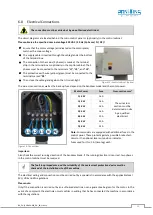
BA_PH_BSB-400-900_EN_44-21.docx
39
Instruction of the operators
It is essential that all operators are regularly and adequately instructed in the use and adjustment of safety equip-
ment such as guards, pushers, templates and table extensions.
Push devices
The push block including its handle or the push stick must be replaced if damaged.
Generally
•
Only use narrow saw blades for curved cutting.
•
When feeding the workpiece, place your hands flat on the workpiece, do not spread your fingers.
•
Do not pull the workpiece back as this may cause the saw blade to run off the rollers.
•
Always feed the workpiece so that the kerf does not close.
•
Always feed the lower edge to the saw blade first when cross cutting upright standing workpieces.
•
Use auxiliary devices also when machining single pieces.
Furthermore, it should be noted that
•
the surfaces of the wheels (especially the lower one) are always free of chips,
•
a functioning scraper brush is present,
•
the chip catcher is attached to the lower bandsaw wheel and is not damaged,
•
blurred or damaged bandsaw blades are replaced immediately,
•
dirty workpieces are cleaned of dirt before cutting,
•
the distance between the hands and the blade is at least 10 cm,
•
and therefore pushing devices are generally used,
•
pushing devices do not get into the cutting area,
•
the bandsaw blade tension is released during rest periods,
•
and the saw blade guard is positioned at table height at the end of work.
12.3
Completion of the Work
When the machine is out of operation, e.g. at the end of a shift, position the saw blade guard all the way down
to the level of the table.
Then release the tension on the bandsaw blade and place a corresponding notice on the machine. The cooling
of the blade alone, which results in a reduction of the saw blade length, will cause pressure marks on the bandsaw
wheel tracks. Furthermore, slight damage to the saw teeth can occur, which can lead to vibrations, etc.
















































